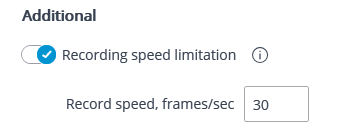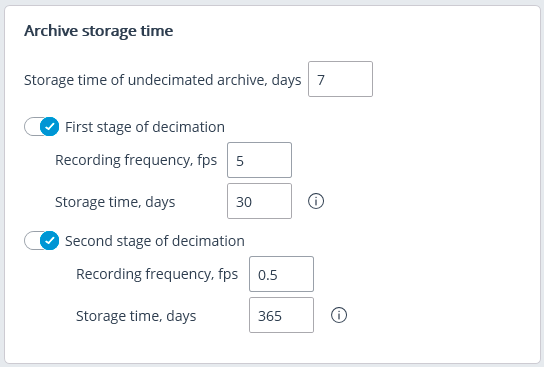Setting up the archive🔗
On the Archive tab you can set up the parameters of writing camera audio and video to archive as well as the parameters of interaction with the archive located on camera.
Below you will find a description of controls located on the tab.
Recording and viewing archive: enables recording of video and audio received from the camera to the archive. When this option is disabled, the ability to view the archive for this camera becomes unavailable in client applications.
Recording mode🔗

Allows selecting one of the modes:
Always on: continuous recording to archive is performed.
By motion: recording to archive is performed only when motion is detected in the frame (also when a set sound level is exceeded in case a sound detector is enabled). Moreover, the operator can start the recording to archive forcibly even if there is no motion in the frame.
Manual: enabling and disabling recording to archive is performed only by the operator and automation scenarios.
Scheduled: allows to flexibly set up modes of recording to archive.
Set schedule: opens the schedule.

In the schedule window opened, select one of the modes by clicking the corresponding rectangle in the upper part of the window. Then, by holding the left mouse button, select the periods when the chosen mode will be active. The corresponding periods will be colored accordingly.
Note
For setting a mode for the whole day, you can select it in the dropdown list located to the right of the day of the week name, or copy it from another day.
Set up server: opens the settings of archive hosting on the server.
Video stream for recording🔗

Shows which stream will be used for recording to the archive on the Eocortex server.
Set up the stream: switches to the Connection tab, which allows selecting the stream to be recorded to the archive.
Additional🔗

Record only key frames to the archive: when this option is enabled, only reference frames will be recorded for MPEG-4, H.264, and H.265 codecs, while for the MJPEG codec, the required frame rate is specified in the Record speed, frames/sec box.
Note
If for MJPEG codec the frame rate of the camera is lower than the one stated in the Record speed, frames/sec box, all frames will be recorded to archive.
Note
For MJPEG codec, Recording speed limitation option is shown.

Warning
Since the sound is not decimated during the recording to archive, it will be available only for the archive recorded without recording speed limitation.
Note
Recording speed limitation influences the quality of video playback from archive and the archive volume: the decimated video recording played back from the archive will be less smooth, but the archive drive space will be saved.
Note
Sometimes there appears a necessity to enable recording without speed limitation only during a specific period of time or as a response to a specific event, and record a decimated video at all other times. In this case, it is required to set up the Scheduled tasks or Tasks by event using Disable frame skipping when recording to the archive.
Sound recording: enables recording sound to archive.
Warning
In order to have sound recorded to archive, enable Sound reception on the Connection tab.
Prerecording and Post recording: using these sliders, you can set short periods of time during which the recording to archive will be performed before the start of the event that triggers the recording and after the start of the event that triggers stops the recording, accordingly. For example, Prerecording is performed when movement or exceeding of a preset sound level is detected, and Post recording is made after the motion has stopped, and the sound level drops below the preset level.
Archive storage time🔗

In this group of settings, you can set minimum and maximum archive storage time.
Note
Generally, the minimum and maximum set archive storage time for each camera assigned to server is analyzed, and an attempt is made to provide for the limitations indicated in the settings. In case it turns out to be impossible, the older recordings from all the cameras will be erased to make room for the archive.
Warning
The archive for a required period may be absent on the camera’s memory card. It happens, for example, when there is no motion, if a motion detector on the camera is used for recording. In this case, the archive on the server will be empty.
For servers with ULTRA and Enterprise licenses, the archive decimation with time is available. Decimation can be configured in two stages: for example, recording is performed at the original frequency of 30 frames/sec; after 7 days, it is decimated to 1 frame/sec; after 14 days, to 0.1 frames/sec (1 frame every 10 seconds).
Warning
If the archive decimation is configured in the system and there is not enough drive space for storing the undecimated archive, the decimation process will start. The values of the archive decimation settings will be used as the archive storage time. This setting can be disabled by turning off archive decimation.

Warning
When enabling archive decimation with time setting, all the archived recordings whose depth exceeds the depth of the undecimated archive specified in the settings will be deleted. The same will happen when the depth of the undecimated archive is modified.
E.g.: initially, the archive decimation with time setting is disabled; the specified maximum time of archive storage is 180 days.
If the first decimation stage is enabled and the time of storage of the undecimated archive is set to 30 days, the archive with the depth of more than 30 days will be deleted at the moment the settings are applied.
If subsequently the depth of the undecimated archive is set to 7 days, the archive with the depth of more than 7 days will be deleted at the moment the settings are applied.
Note
For the MPEG-4, H.264 and H.265 codecs, only the reference frames will be recorded.
In case of playback of the archive in Eocortex Client, archive fragments, which have been decimated with time, will be displayed by the shaded area on the timeline.
Archive on device🔗

Usage of archive on data storage card: enables access of Eocortex applications to the data storage card on the camera.
Synchronizing with main archive: if this option is enabled, the archive from camera will be downloaded to Eocortex server, but only of those periods when no connection with camera was available or the server was down.